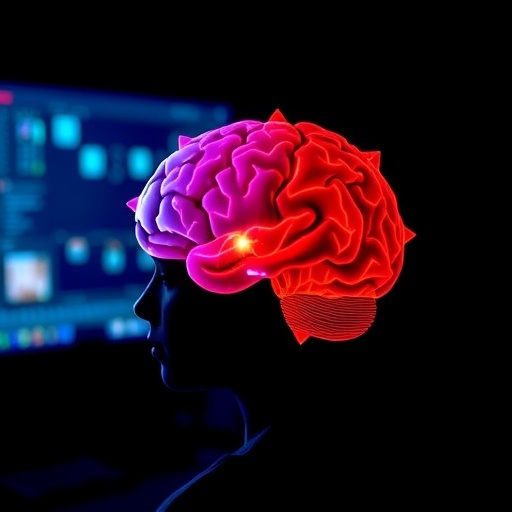In a groundbreaking study published in BMC Pediatrics, researchers explored the intricate relationship between screen time and mental health symptoms in preschool children diagnosed with autism spectrum disorder (ASD). As screens have become ubiquitous in modern childhood experiences, the implications of their usage extend beyond mere entertainment, touching on critical issues of mental health. In this detailed exploration, the authors, Chen et al., sought to uncover the underlying mechanisms connecting excessive screen exposure to heightened levels of anxiety and depression.
The research, driven by the urgency to address mental health in young children, particularly those with ASD, identified a crucial mediating factor—the child’s cortical volume. This term refers to the thickness of the cerebral cortex, which is often linked to cognitive functions and emotional regulation. The study posits that increased screen time can lead to alterations in cortical structures, potentially exacerbating symptoms of anxiety and depression. Understanding this relationship can provide valuable insights for parents, caregivers, and clinicians striving to promote healthier screen habits.
As society grapples with rising screen usage, the parameters of what constitutes ‘excessive’ have become a topic of considerable debate. The American Academy of Pediatrics has provided guidelines suggesting limited screen exposure for young children, yet many parents report difficulties adhering to these recommendations amidst the demands of daily life. Chen and colleagues found that preschool children engaged in extensive screen time not only exhibited signs of anxiety but also displayed notable depressive symptoms that could severely impact their emotional well-being.
The interplay between screen time and mental health is multifaceted. The study highlighted that while the immediate effects of excessive screen usage might manifest behaviorally, their roots often lie deeper within neurological changes. The researchers employed advanced neuroimaging techniques to evaluate the cortical volume of children engaged in varying degrees of screen time. They discovered a disturbing trend: children who spent significantly more time on screens had reduced cortical volume, particularly in areas associated with emotional processing.
What does this mean for our understanding of childhood development? The findings suggest that changes in brain structure could mediate the relationship between high levels of screen time and the emergence of anxiety and depressive symptoms. This revelation underlines the importance of establishing a balanced approach to screen time, particularly for children with ASD, who may already be navigating the complexities of emotional regulation. Mental health professionals are encouraged to consider these implications when working with young patients.
Interestingly, the study also explored the nature of screen content. Not all screen time is equal; educational programming may offer different cognitive benefits compared to passive entertainment. By analyzing the types of content children engage with, the researchers aimed to tailor recommendations that not only limit screen time but also promote healthier viewing habits. This distinction is vital for crafting strategies that could mitigate the adverse effects of screen exposure while still recognizing the educational potential of certain media.
As part of the research design, the authors gathered data from a diverse cohort of preschool children diagnosed with ASD, utilizing both qualitative and quantitative measures to assess their screen habits. This comprehensive approach allowed for a nuanced understanding of how various factors—such as parental guidance, peer interactions, and environmental context—might influence the relationship between screen time and mental health outcomes. Doggedly collecting data through a variety of methods yielded profound insights that assert the critical need for parent education on monitoring screen use.
Furthermore, the implications of this research extend beyond academia into the realms of public policy and parental guidance. Schools and childcare programs might consider integrating screen time management into their curriculums, equipping both educators and families with tools to navigate these digital waters. The challenge lies in striking a balance that allows for modern engagement without jeopardizing the mental health of children. As the digital landscape evolves, so too must our strategies for fostering healthy development in young minds.
In summary, the study by Chen et al. offers a vital contribution to understanding the cognitive and psychological effects of screen time on preschool children with autism spectrum disorder. By revealing the mediating role of cortical volume, it establishes a connection between digital exposure and mental health that demands attention. Parents and caregivers should be vigilant in regulating screen use and ensuring that children have access to healthy outlets for play, socialization, and learning outside of digital devices.
Ultimately, this research is a call to action. It urges for a collective effort from parents, educators, and healthcare professionals to address the rising issue of screen time and its implications on children’s mental health. The task is significant, but by working together, we can cultivate a generation that thrives not just in the digital age but also in emotional resilience and psychological well-being.
Understanding the nuances of children’s interactions with screens is imperative if we are to navigate the complexities of modern childhood. As digital natives grow older, the lessons drawn from this important study will guide future research and public health strategies, ensuring a comprehensive approach to mental health that encompasses the realities of contemporary life. The road ahead may be uncertain, but with ongoing dialogue and inquiry, there is hope for healthier futures.
In conclusion, the findings presented by Chen and colleagues have sparked an essential discourse that transcends the realm of academia, influencing policy and parenting practices alike. It serves as a reminder that technology, while advantageous, carries the weight of responsibility. Balancing screen time with traditional play and interaction is not just beneficial; it is critical for nurturing healthier, happier children.
Subject of Research: The relationship between screen time and anxiety/depression symptoms in preschool children with autism spectrum disorder.
Article Title: The relationship between screen time and anxiety/depression symptoms in preschool children with autism spectrum disorder: the mediating role of cortical volume.
Article References: Chen, R., Bai, Ms., Zhao, T. et al. The relationship between screen time and anxiety/depression symptoms in preschool children with autism spectrum disorder: the mediating role of cortical volume. BMC Pediatr 25, 818 (2025). https://doi.org/10.1186/s12887-025-06203-5
Image Credits: AI Generated
DOI: 10.1186/s12887-025-06203-5
Keywords: Screen time, anxiety, depression, preschool children, autism spectrum disorder, cortical volume.
Tags: anxiety and depression in childrenautism research and findingscortical volume and cognitive functioneffects of excessive screen exposureemotional regulation and screen timeguidelines for children’s screen usageimplications of screen time on mental healthmental health in preschool childrenparental guidance on screen timepromoting healthier screen habitsrelationship between screen time and anxietyscreen time and autism spectrum disorder





